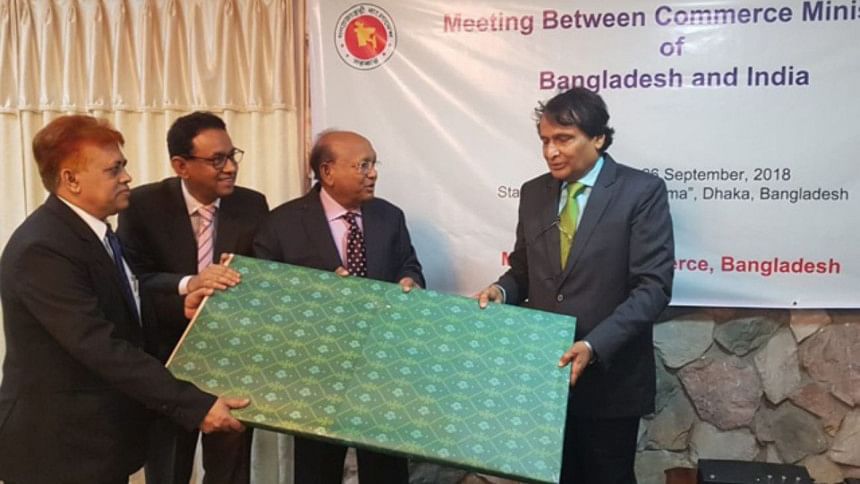CEPA: A game-changer for Indo-Bangla ties?

Bangladesh and India decided during a meeting between their Commerce Ministers Tofail Ahmed and Suresh Prabhu in Dhaka recently to explore a bilateral Comprehensive Economic Partnership Agreement (CEPA) which is an important stage in the countries' burgeoning ties. If taken to its logical conclusion, CEPA will mark a major expansion of bilateral economic cooperation. CEPA goes far beyond a free trade agreement in goods, which the two countries have been tentatively talking about for quite some years, by taking a holistic view of covering goods, services, investment and infrastructure projects like power and physical connectivity.
However, CEPA is easier said than done and its finalisation is going to be a long haul. It took several years for India to sign its Comprehensive Economic Cooperation Agreement (CECA) with South Korea, Singapore and Japan and they are reviewed and amended from time to time following India's concerns over some aspects like greater market access to Indian goods and Indian professionals in services sectors of those countries. India and the 10-nation Asean signed an FTA in goods in 2009 and the two sides have been busy negotiating the CEPA between them for the last few years.
For the last six years, India has also been in talks with the 16 member countries of Regional Comprehensive Economic Partnership (RCEP), including China, for a trade pact that aims to cover goods, services, investments, economic and technical cooperation, competition and intellectual property rights. The pace of negotiations for the pact has not been encouraging because each country has its own interests to protect and concerns to address. The RCEP bloc comprises 10 Asean countries (Brunei, Cambodia, Indonesia, Malaysia, Myanmar, Singapore, Thailand, the Philippines, Laos and Vietnam) and their six FTA partners India, China, Japan, South Korea, Australia and New Zealand.
India has flagged its concerns over the RCEP on sectors like textiles, steel and food processing in the event of a sharp cut or removal of customs duties on these items because it fears that this would lead to cheaper Chinese goods swamping the Indian market. In 2017-18 India's trade deficit with China increased to USD 63.12 billion and thus India wants more liberalised norms to promote the services sector. However, India has not shied away from RCEP which offers a huge opportunity to its services sector.
Similar concerns are likely to come into play when Bangladesh and India negotiate the CEPA. The biggest challenge for the countries will be the stark asymmetry in their economies and size of their manufacturing bases.
One way of navigating the tricky path is for the private sectors of both the countries to go for joint ventures with buyback arrangements and exports to other countries. This acquires more importance because Bangladesh will graduate from the Least Developing Country status by 2021 and lose duty-free and quota-free facilities for its goods in the Indian market.
Agro-processing, automobiles, ceramics, chemicals, gems and jewellery, light engineering, ICT, hospital and medical equipment, pharmaceuticals, plastics, professional services, tourism and textiles could be among the sectors for joint projects by entrepreneurs of India and Bangladesh. Bangladesh enjoys preferential market access in the US and Western Europe and will continue to do so for some years. Therefore, a joint venture between Bangladeshi and Indian investors could be mutually beneficial, more so as US President Donald Trump threatens to hike import duties on Indian goods.
Bangladesh enjoys competitive labour costs and Indian investors can capitalise on this to manufacture in Bangladesh for the north-eastern Indian states which are making rapid strides and offer an attractive market. A number of leading Indian companies like Hero MotoCorp, Tata Group and CEAT have already set up such projects in Bangladesh. But a strong political push and much bigger investments are required.
The natural resources of the north-eastern Indian states can be taken to Bangladesh for value addition there and re-exported to India or beyond. In fact, this is already taking place but on a small scale. The setting up of India-Bangladesh joint ventures or Indian investments in Exclusive Economic Zones in Bangladesh will go a long way in addressing the latter's persistent concerns over the big trade gap with India. When Prime Minister Sheikh Hasina visited Delhi in April 2017, a dozen MoUs were signed by mostly private investors of the two countries for projects in Bangladesh. But MoUs are mere statements of intent and both sides have to follow them through in order to enhance the visibility of such projects and credibility of their cooperation.
There are lessons to be learnt from India's CEPA and CECA with Japan, South Korea and Singapore. One of the biggest gains for India from these agreements is that all the three countries have turned out to be key sources of foreign direct investment in infrastructure and manufacturing sectors. Almost all South Korean and Japanese electronic goods manufacturers have set up their assembling and manufacturing plants in India to cater to the huge domestic market and also to export them to other countries. Though not of the same stature as Japan and South Korea as yet, India is emerging as a technology powerhouse from which South Asia can benefit.
Bangladesh and India have in recent years recorded high growth. They must explore how CEPA can promote their economic integration by aligning some of their policies.
Pallab Bhattacharya is a special correspondent to The Daily Star.








Comments